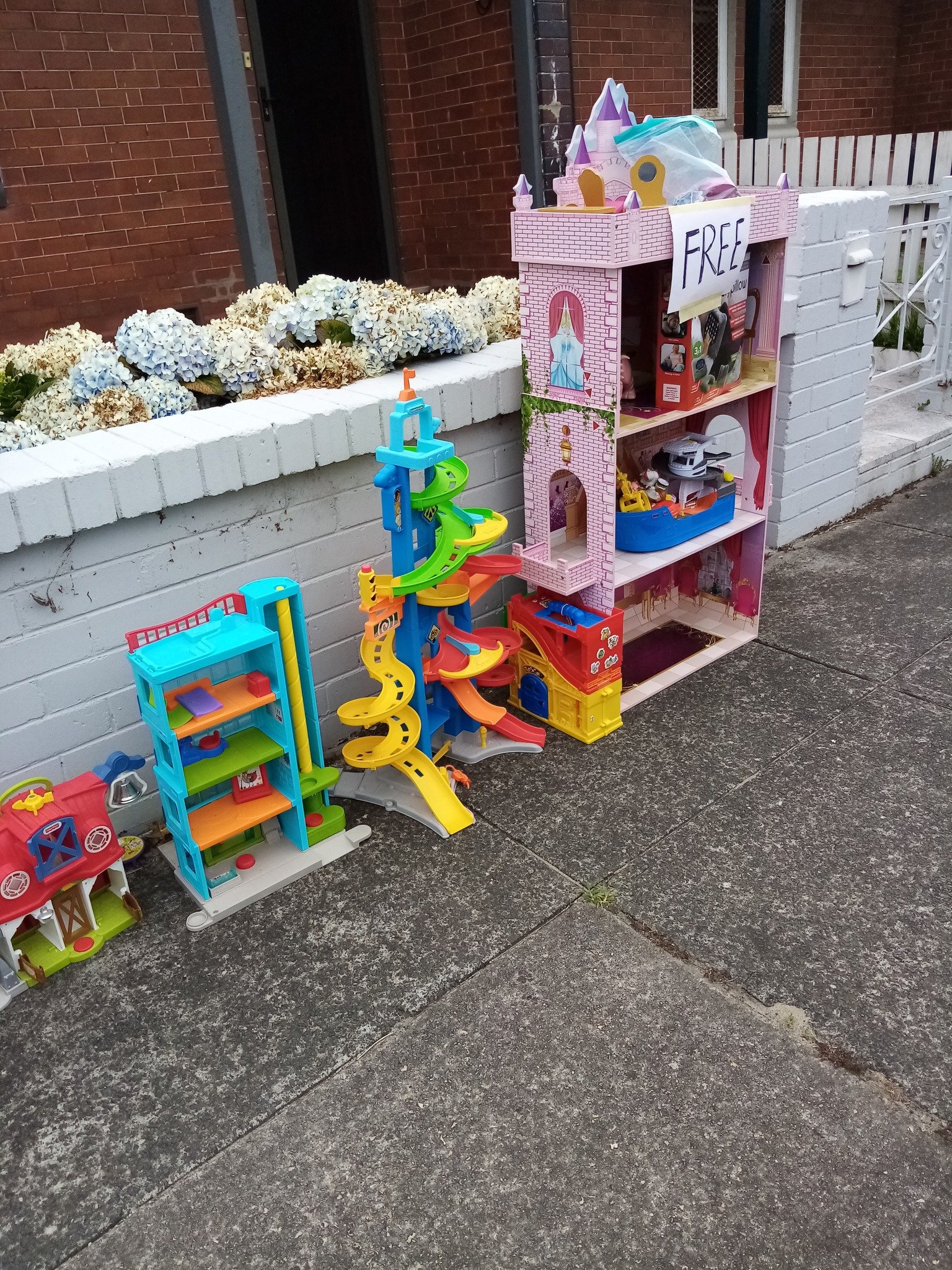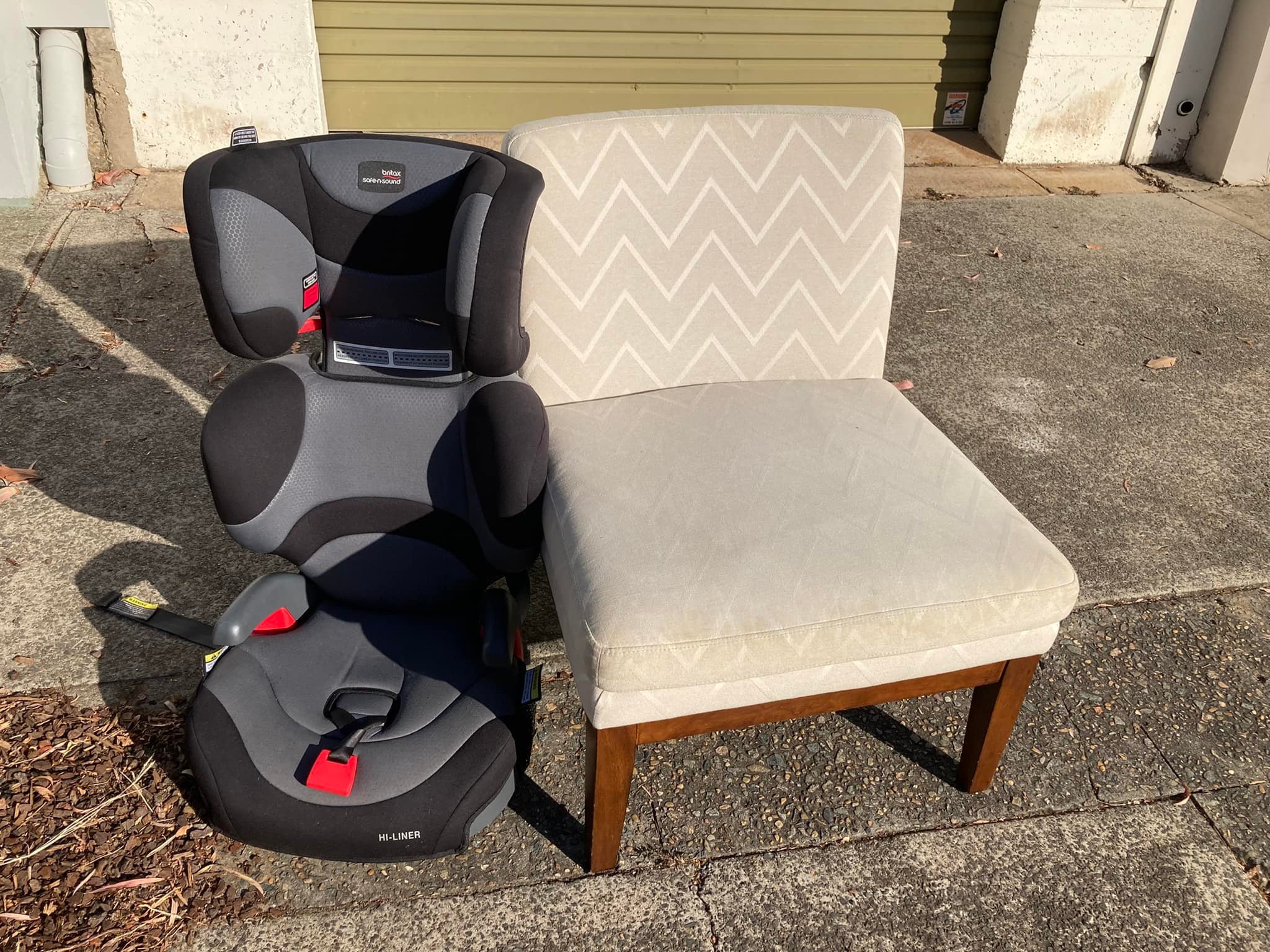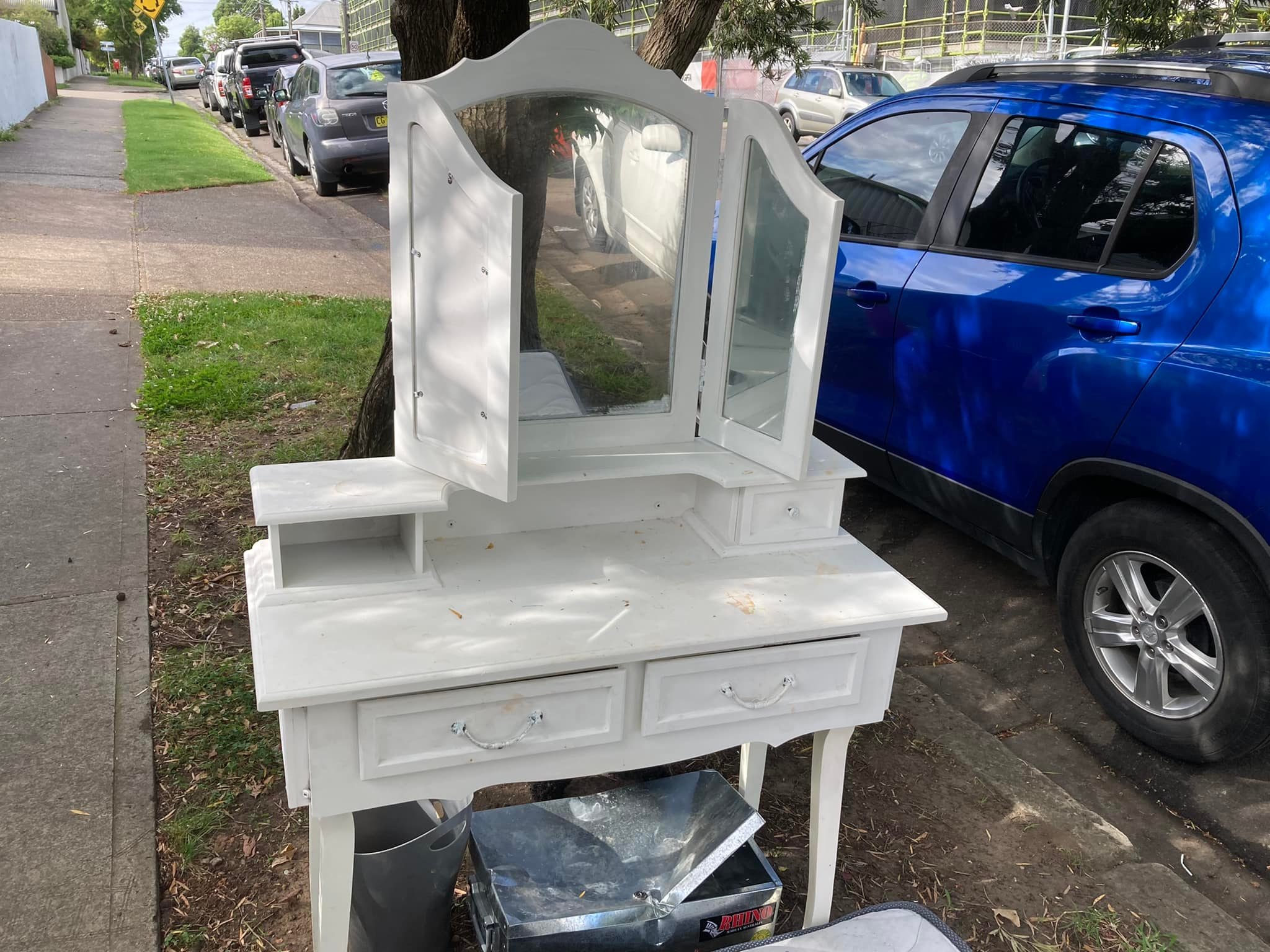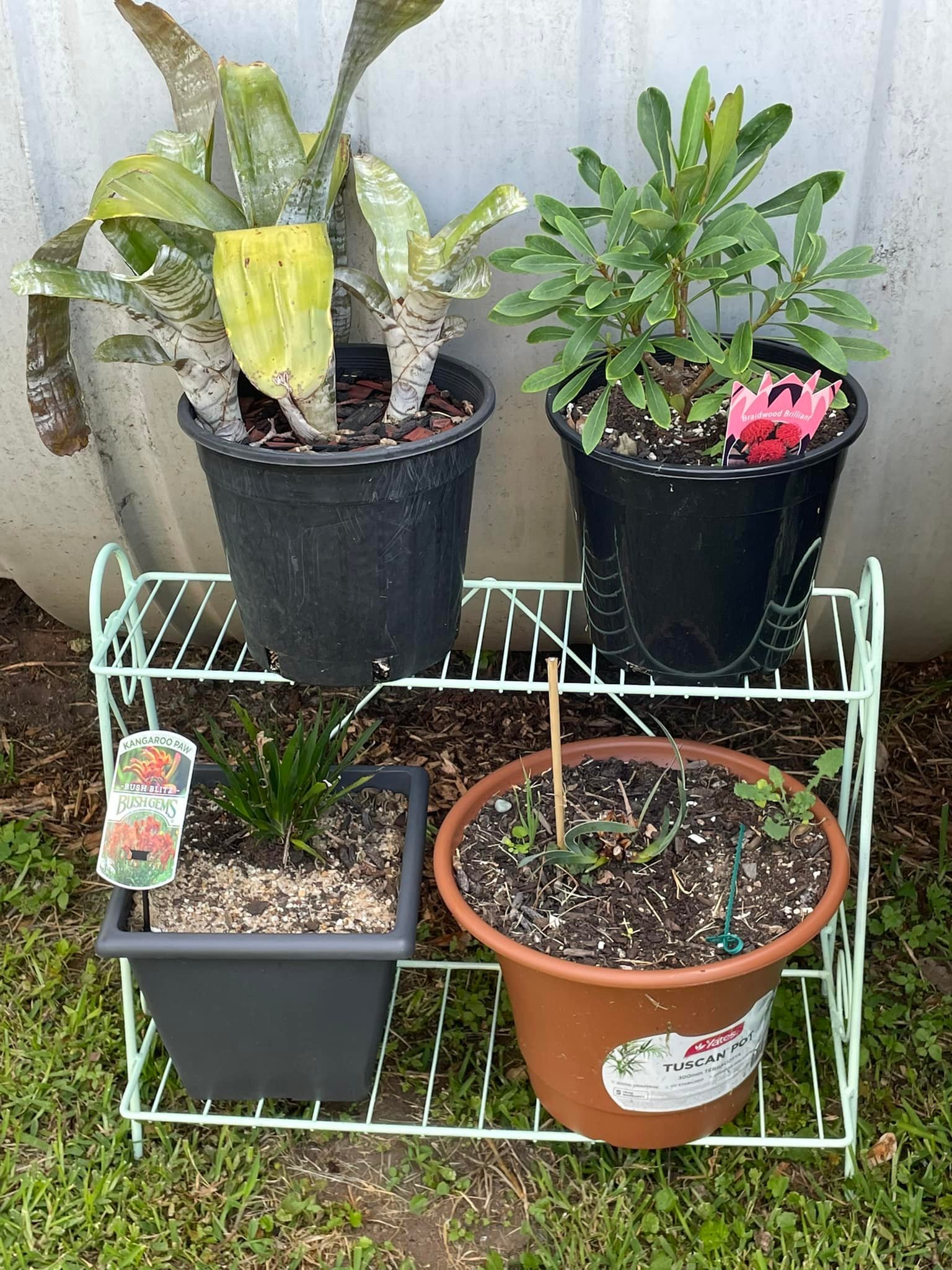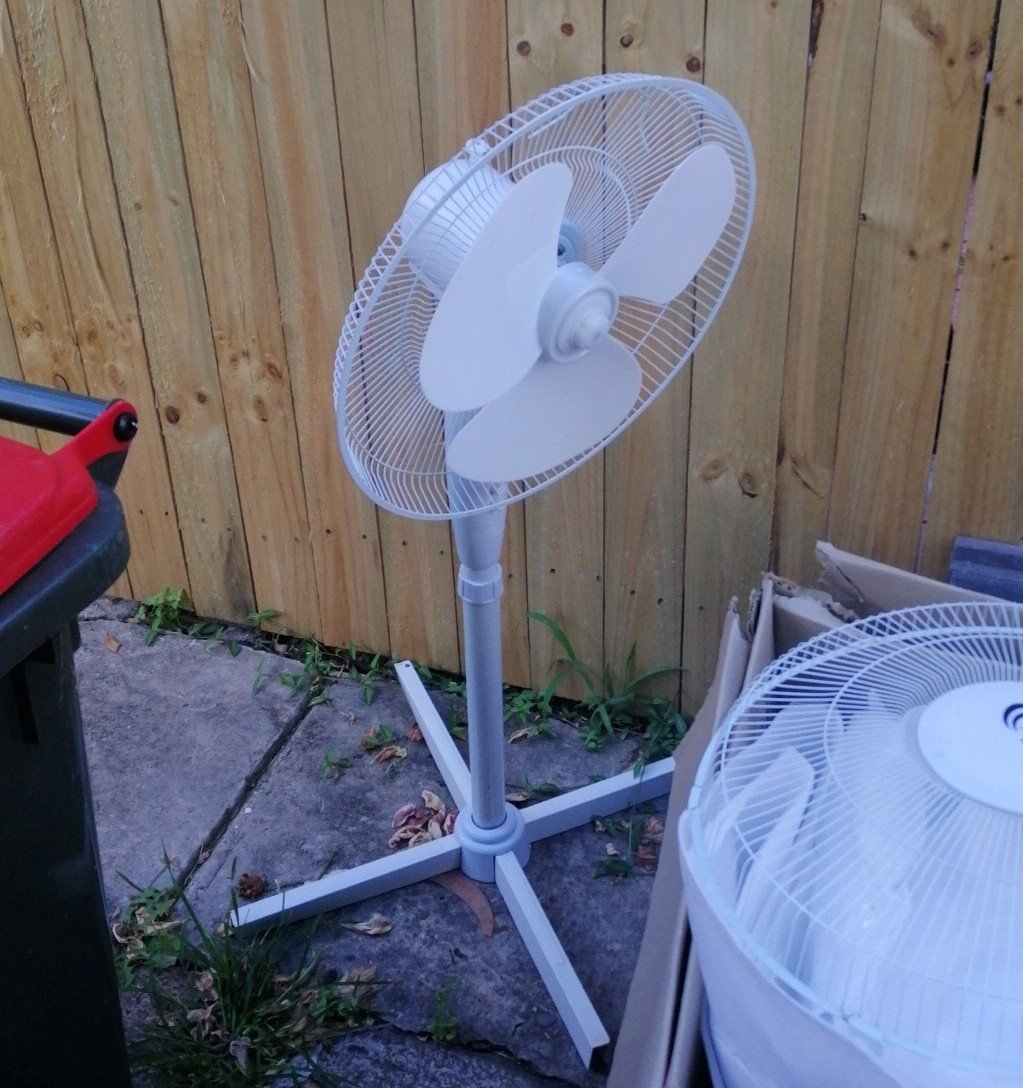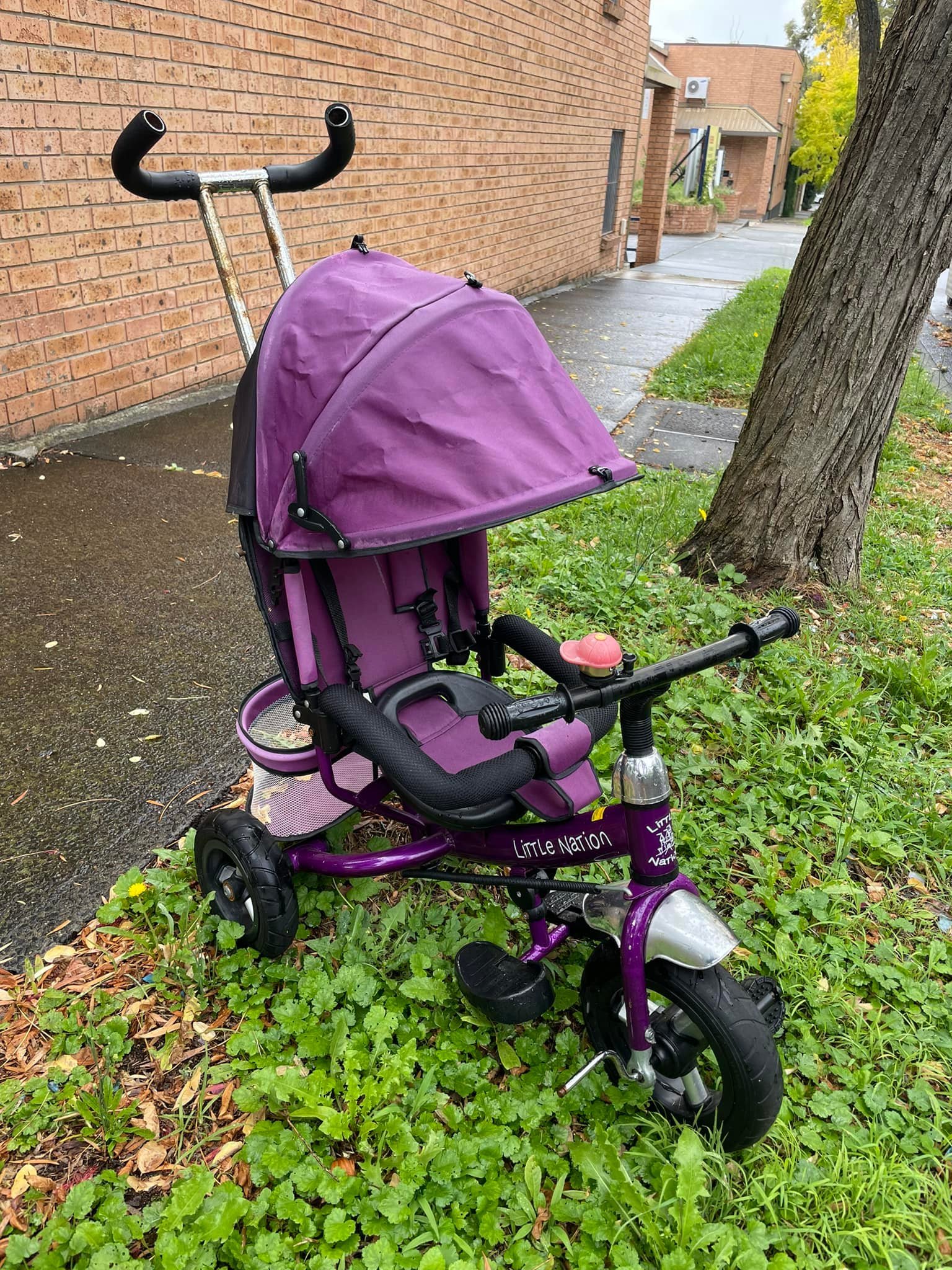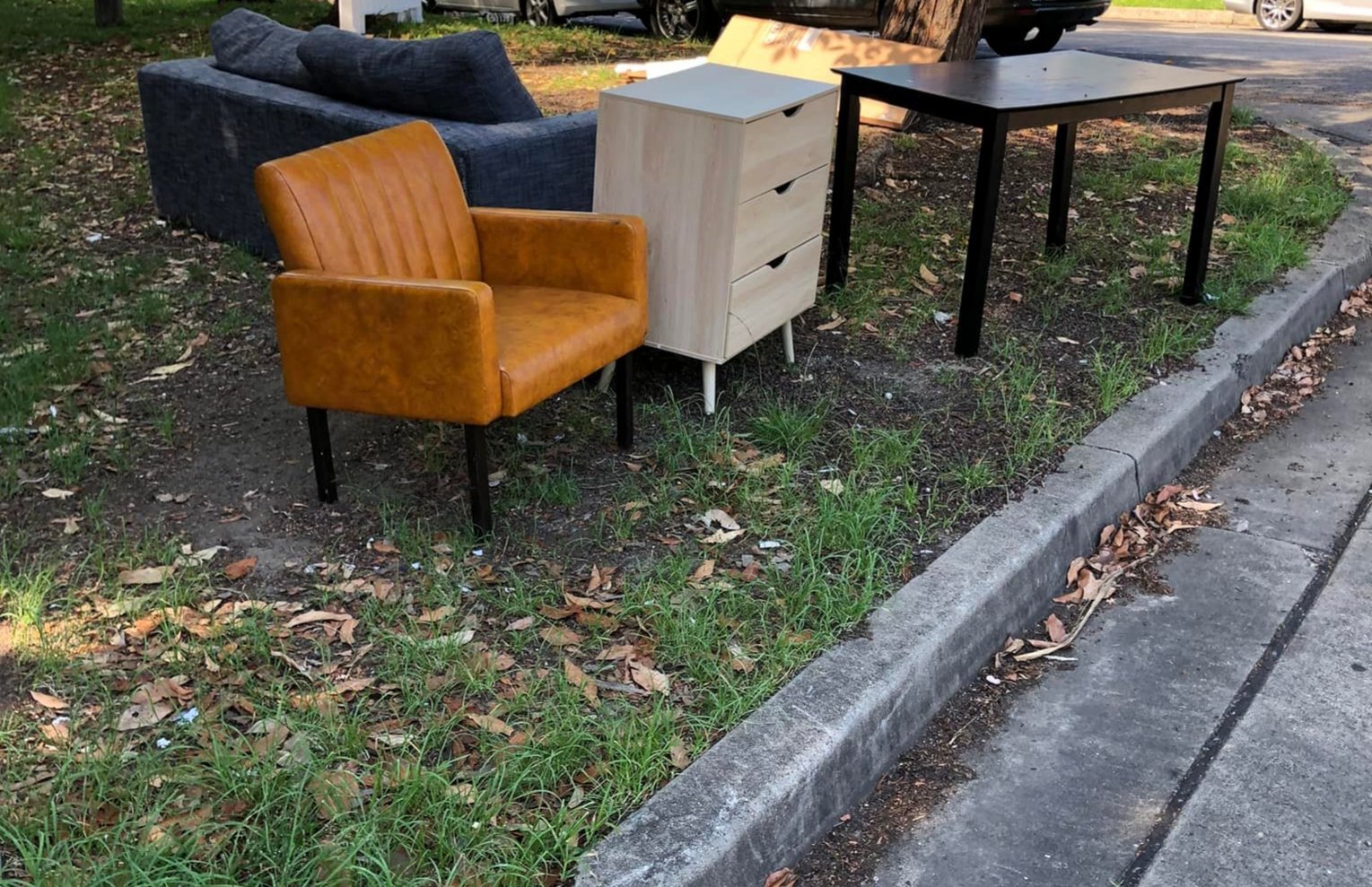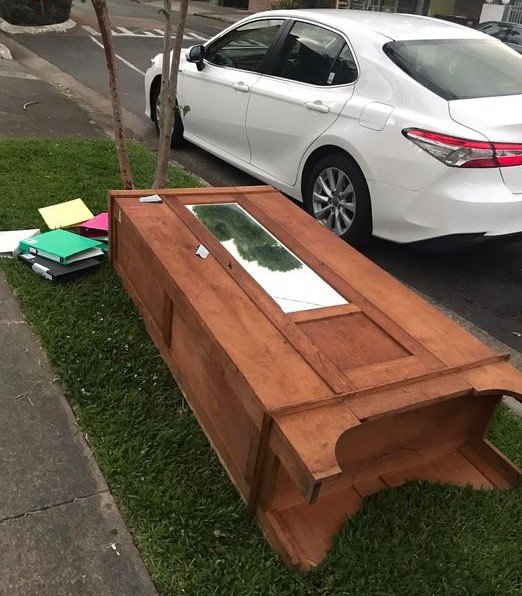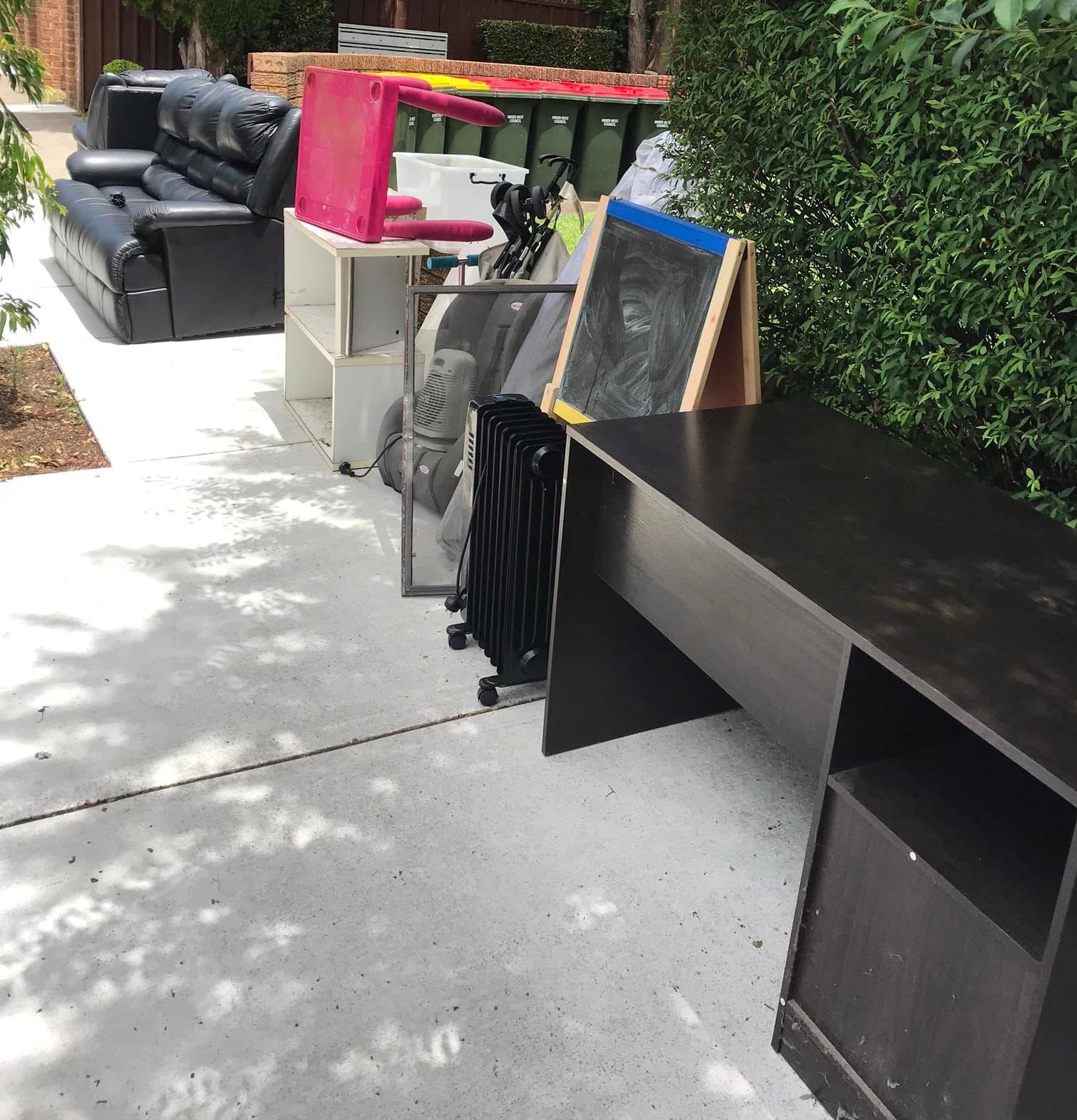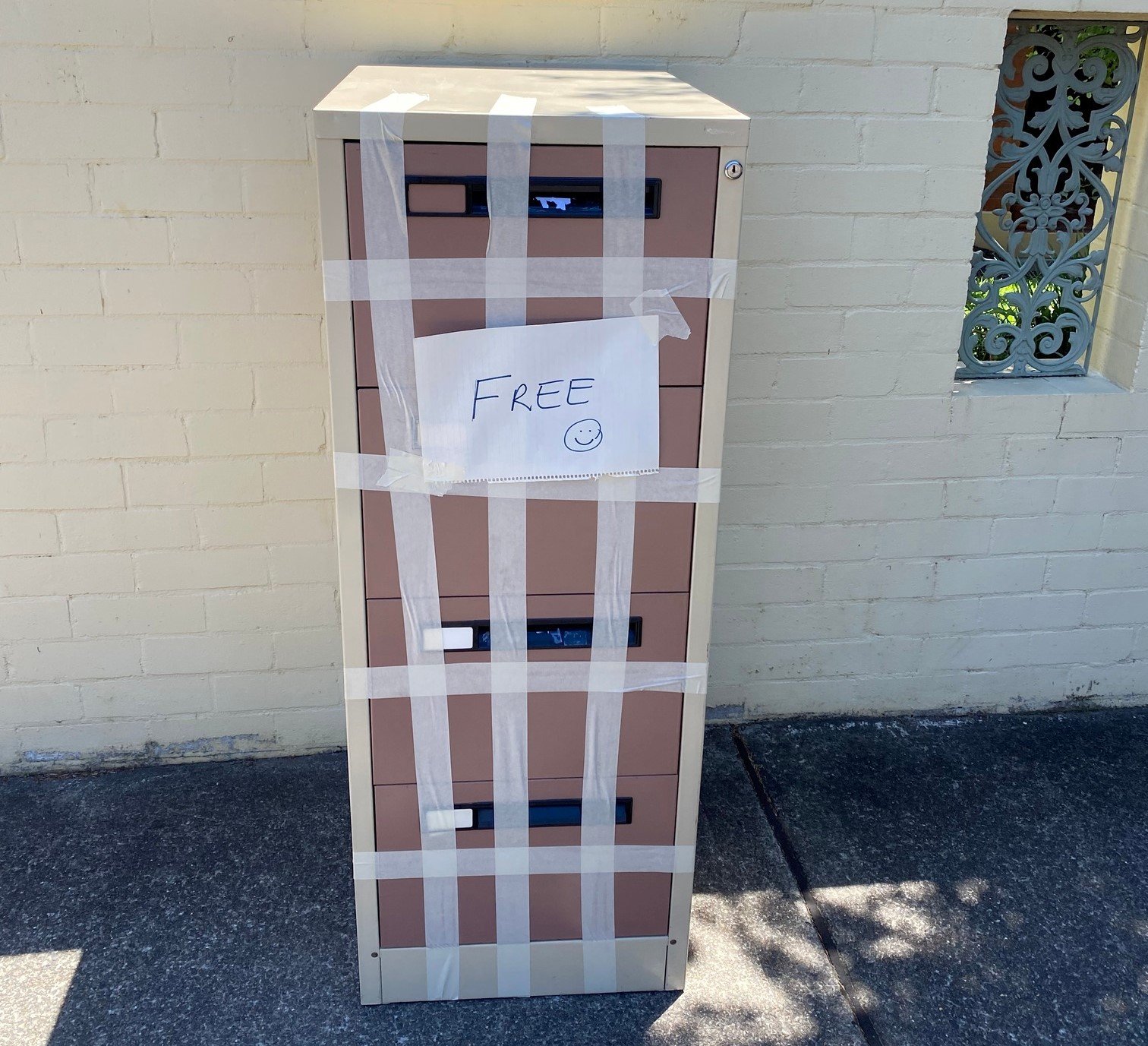Image credit: Chantel Bann
I was out on a walk the other day and spotted a ‘FREE’ sign in front of someone’s house above a couple of art frames, a lamp, clothes rack, mirror, a chair and some books. It’s pretty common to see household items on the sidewalk, free for passers-by to take. I’ve come across everything from sofas to tvs, suitcases, washing machines, clothes, printers, desks, electronics and even fresh fruit.
I found out about a community Facebook group called Street Bounty Inner West where locals in a suburb can post reusable items they see in the street for anyone to pick up. The group aims to “promote the recycling and reuse of materials, keeping kerbs cleaner, landfill emptier and wallets fuller.” Movements like this divert so much stuff from going to landfills. However, sometimes these items can get damaged on the sidewalk by exposure to weather conditions: rain, extreme sun and wind. And/or eventually still end up in landfill if nobody takes it.
Images credit top row L to R: Kimberly Scott, Fi Paskulich, Anna Bailey, Obaydah Vetter. Second row L to R: Nicky Lewis, Sarah Bea, Carolyn Veg Ienna and Vanessa Jimenez.
The world’s waste
According to The World Counts, the world dumps 2.12 billion tonnes of waste each year. If it were all put on trucks, it would stretch around the earth 24 times! Part of the reason why this figure is so high is that 99% of the stuff we purchase is trashed within 6 months. According to the World Bank, global waste is expected to grow to 3.40 billion tonnes by 2050. A huge majority of the world’s waste is generated by countries in the global North like Australia, the US, the UK, and Canada.
According to Australia’s National Waste Report 2020, Australians generated around 74.1 million tonnes of waste in 2018-19 (this includes household waste, organics, masonry materials and ash). Community efforts like Street Bounty that salvage household waste from landfills by donating to random strangers are a noble act. Many movements like this are doing fantastic work in tackling the waste problem but they can only capture a tiny fraction of the overall waste that exists.
Planned obsolescence
It’s fair to say that planned obsolescence is probably the biggest factor behind the tremendously high amount of waste. It’s a modern capitalist trend that’s been a massive catalyst for manifesting more waste in the last few decades than humanity has ever witnessed. Planned obsolescence is a strategy during manufacture that ensures products are deliberately designed with an artificially limited useful life or designed to eventually slow down or become obsolete. This guarantees that consumers will regularly want to replace these products in the future. The purpose of this strategy is for corporations to gain stable and increased profits. The outcome is a massive increase in waste to landfills and huge greenhouse gas emissions that contribute to climate change and environmental degradation.
Image credit: How-To Geek
Common waste streams
E-waste
Electronic waste (e-waste) is the quickest growing domestic waste stream. On a global scale, we generate over 50 million tonnes of e-waste each year. Only 20% of this is formally recycled. That comes to about 7.3 kilograms per person and the equivalent in weight to 350 cruise ships. The e-waste produced annually is worth over $62.5 billion. A lot of e-waste is toxic and gets exported to poorer countries in the global South where they end up polluting the environment in these countries and also in their landfills.
The average Australian household produces about 73 kg of e-waste a year. With a projection of a global total e-waste increase to 74.7 million tonnes (almost twice the amount of new e-waste in just 16 years). Planned obsolescence is a big feature in the electronics industry.
In 2018, Italy fined Samsung and Apple for purposely slowing down older models of their phones. Their plan was for people to get annoyed with the slowness of their phones to the point where they were forced to buy the newest and much more expensive models.
Image credit: Carolyn Veg Ienna
Furniture waste
With the popularity of flatpack furniture over the last few decades, there’s been a boom in furniture waste. When people are relocating, it can be more convenient to throw away old or damaged furniture instead of repairing or paying to move them to the new location.
Each year, Americans throw out more than 12 million tons of furniture and furnishings, according to the Environmental Protection Agency. Only a small percentage is recycled. And in Australia, households dispose of around 24 kg of wooden furniture each year.
Image credit: Blake Milne
Images credit: Bee Yolanda, Clare Marshall, Jobi-Zane Pixus and Tom.
Waste from fashion & textiles
We’re producing about 150 billion garments a year with only 7.8 billion humans. It’s not surprising that 84% of all new clothing produced ends up in landfills each year. Fast fashion is to blame for these alarming figures.
Fast fashion brands through clever marketing amongst other things manipulate consumers into buying new clothes every few days or every week. These clothes usually get thrown out very quickly as trash and a huge portion is exported to countries in the global South where they eventually pollute those environments. Overconsumption is a modern cultural trend that’s detrimental to people and the planet. Fashion trends are one of the things that fuel fashion waste.
Image credit: CALPIRG
Solving the waste crisis
Australia has a national target of recovering 80% of waste by 2030. To make ambitious goals like this in Australia and other countries a reality, we’ll have to do a lot more than sidewalk donations. It’s so necessary to break the planet-destroying linear cycle of stuff that goes from retail to buyer then landfill in less than a year. In spite of planned obsolescence and our behaviours around consumption, many items are still useful and can be repurposed. A couple of ideas:
1. Make profits for yourself and charities
Reselling has always been a phenomenal way to divert waste from landfills and make a profit. However, CharityBay is next level! On this platform, you can do both of these things and help charities at the same time. People can sell items and donate some or all profits to a chosen charity. Imagine if all the stuff abandoned on the street and the useable stuff sent to landfill were resold for charity.
2. Rescue, Reuse, Repair, Repurpose
There are many community groups like the Street Bounty Inner West group that support waste reduction. You might find similar groups through a search on social media platforms. If you can’t find one for your local community then create one.
With a little love, imagination and a makeover, many items have the potential for a magical transformation into something ‘new’, useful and maybe even beautiful. Imagine what our societies would be like if repairing and upcycling were as much a cultural habit as overconsumption?
Image credit: Imran Zainal © Imran’s Ark via iProperty
3. Legislation and policy change
Local community action is very powerful but it’s only one piece of the puzzle. We have to have laws in effect that ban planned obsolescence. And
hold corporations accountable for ensuring durability and lifelong repair guarantee in the products they make
limit the number of goods manufactured to a reasonable number in harmony with planetary resources and product demand / usage
hold corporations accountable if they do not comply with these laws.
♥ Nina Gbor
Insta: @eco.styles


